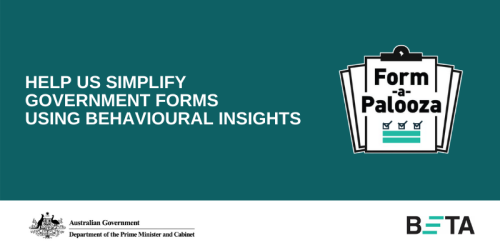
Forms are everywhere. They reach every facet of our lives, from applying for a driver’s licence to visiting the doctor, buying a car, joining a new gym, or filling in our tax return.
We’ve all come across frustrating, unclear forms that loiter unfinished in our kitchen or on our computer desktop.
But does it really matter? Is form design an issue that governments should care about?
BETA thinks so. The team recently ran Form-a-Palooza, a one-day festival of forms, to train 200 Australian public servants to design better forms.
At the event, BETA laid out four big reasons for governments to take this seriously.
1: Poor form design is a dis-service to the public
Forms are typically the gateway for people to access something they need. A badly designed form can turn people away from accessing services or opportunities to which they are entitled.
People waste time and effort on needlessly long and complicated forms—but sometimes those delays can lead to people missing out entirely on a government service they desperately need.
If people miss out on healthcare or social security as a result of a poor form, there is a huge social cost.
2: Well-designed forms will help build trust in government
It’s clear that, in most countries, public trust in government is declining.
The public has come to measure public services not against traditional government peers but against smooth, personalised, and “always on” experiences they interact with every day in the private sector.
The bar has been lifted.
And we know from the work of the OECD that there is a strong positive correlation between satisfaction, competence and trust in government institutions.
In other words, repeated good experiences with government forms will satisfy the public, build a sense of competence and lead to greater trust.
Conversely, there is little tolerance for poor service delivery.
In fact, McKinsey has found negative customer experiences affect overall customer-satisfaction scores four times more than positive ones.
One bad form can undo the goodwill from a series of good experiences and tarnish the reputation of a program, an agency and government.
3: It will save money and free up resources
Good form design will reduce complexity, friction, and unnecessary work from customer-facing processes.
This leads to less time fielding complaints and enquiries, saving the government time and money.
The good news is we don’t need to look too far to see great leaps forward being made within the Australian Government.
The introduction of MyTax at the ATO has made a tremendous impact. In 2017, more than 3.5 million people used this service and 80 million pieces of information were prefilled into the tax returns.
This change, among others, have boosted client satisfaction, volumes and speed of processing. Within three years, the number of people receiving tax refunds within 5 days has increased from zero to 73 per cent.
4: Good form design will build employee engagement and satisfaction
Improving the public’s experience with forms can also improve the morale of public servants.
Studies identify a direct link between employee engagement and a positive customer experience. 5. Well-run programs give employees a focus and a common, unifying purpose centered on the people they are serving.
We need look no further than the ATO itself. The ATO’s APS Census results show continued improvement in staff engagement, now at the highest level since the survey began. Unplanned leave has fallen for 4 years straight, coinciding directly with the introduction of their ‘reinvention agenda’.
In short, good quality government forms can drive a virtuous cycle of better outcomes, more trust and more efficient services.
Stay tuned. BETA’s next blog post will run through our framework for better form design, which draws on behavioural science to make forms easier, simpler and more human.

